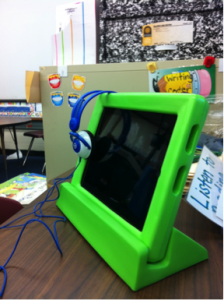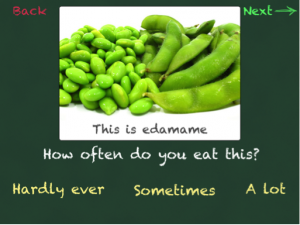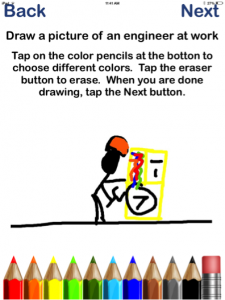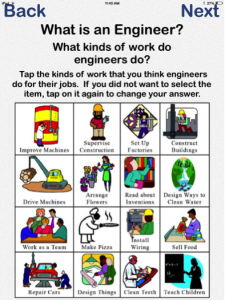Greetings from the University of Chicago! We are Sarah Rand, Amy Cassata, Maurice Samuels and Sandra Holt from Outlier Research and Evaluation at the Center for Elementary Mathematics and Science Education. Our group recently evaluated two Chicago-based elementary education programs: Purple Asparagus, a nutrition education program and Science, Engineering, and Technology for Students, Educators, and Parents (SETSEP), a science and engineering program for students and their parents.


Purple Asparagus was interested in the program’s impact on children’s willingness to try new foods, attitudes about eating fruits and vegetables, and actual eating habits. A major challenge we faced was how to measure changes in the eating habits and attitudes of 6- and 7-year-olds, an age that is considered too young to complete a traditional survey. In the SETSEP evaluation, our challenge was finding an efficient way to collect student outcome data from 1st-3rd grade students that minimized the amount of time taken away from program activities. We also needed a method of data collection that would capture students’ attention and accurately represent their perception of an engineer.
Lesson Learned: It was because of these dilemmas that we explored the potential to create iPad apps to measure student outcomes for each program evaluation. We worked iteratively with an app developer to create engaging, child-friendly platforms for students to share their experiences and feelings.
Click here to see a video of the Purple Asparagus App in action.
Click here to see a video of the SETSEP app in action.


The administration of the iPad app was a great success. We collected data from almost 200 participating students. Students remained focused on the survey for the five to ten minutes it took to complete. Most students had previous experience using an iPad and were familiar with the touch screen. Student response to the app was very positive and many students commented that taking the survey was a fun experience!
Rad Resource: We worked with Matt Jankowiak from Region Apps to program these apps.
Cool Tricks: We bought these iPad cases and these headphones, which were great for students.
Lessons Learned: App development takes time. We were new to app development, so the learning curve was steep at first. There are many pieces to consider including ease of use for young children, audio recordings, and collecting images for the app. It’s also a good idea to test the app with students before administration.
Note: Survey questions for the engineering app were developed by Engineering is Elementary at the Museum of Science, Boston and were used with permission.
The American Evaluation Association is celebrating Chicagoland Evaluation Association (CEA) Affiliate Week. The contributions all this week to aea365 come from CEA members. Do you have questions, concerns, kudos, or content to extend this aea365 contribution? Please add them in the comments section for this post on the aea365 webpage so that we may enrich our community of practice. Would you like to submit an aea365 Tip? Please send a note of interest to aea365@eval.org. aea365 is sponsored by the American Evaluation Association and provides a Tip-a-Day by and for evaluators.

I read through your post and I think that the development of the survey app for the children was a brilliant idea. We are currently looking at how well a local school district’s recent implementation of iPads in elementary schools and one of the objectives is to measure how much time the students spend on school related apps versus non-school related apps. We were thinking about surveying the students using a traditional online survey, but the survey app approach seems much more appropriate. The school district has a list of apps that the teachers use, so gauging how much time the students spend on the apps may also determine how effective the apps are across the school. Really glad I ran into this post. I plan on checking out the SETSEP app as well since I am interested in expanding my own sons’ exposure to STEM-related programs and apps.